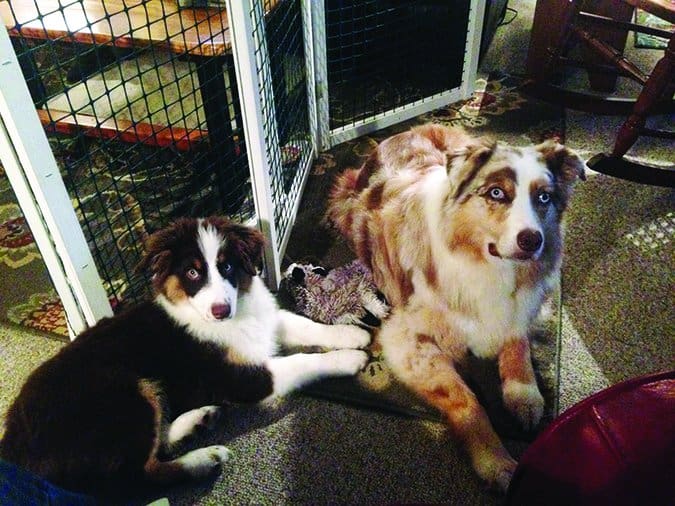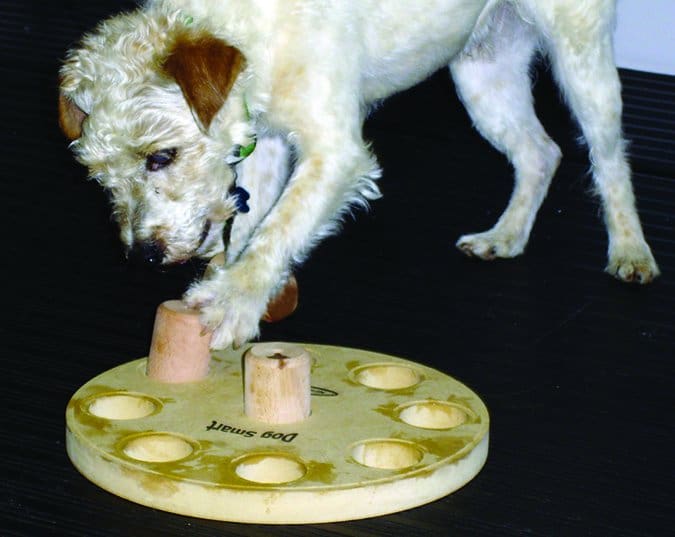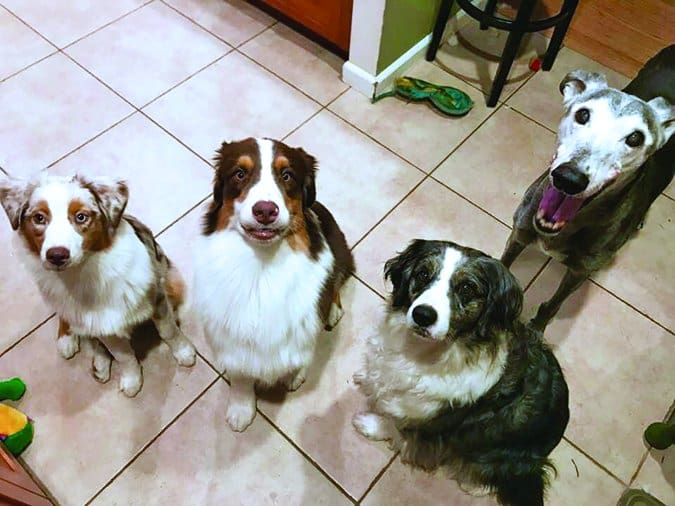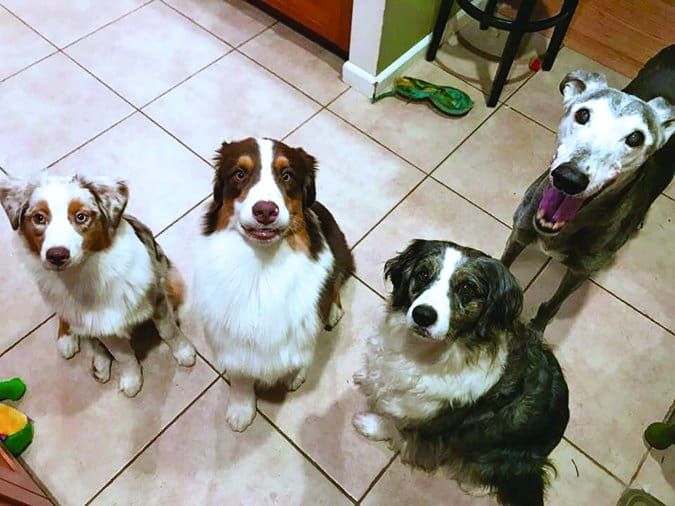For many of us who love dogs, our canine family members are a lot like potato chips – we can’t have just one. There are so many dogs out there, each with love to share and insights to offer, each needing love and care, that the idea of restricting ourselves to a single canine companion is simply unthinkable. Our four-legged pals complement each other’s strengths and weaknesses, and fill our hearts and homes with joy and love (and fur).
Of course, the joy of caring for and loving multiple canines brings with it a whole host of potential challenges as well. Fortunately, it’s possible to live with, manage, and/or overcome most of them.
Recently, for the first time in more than 40 years, my husband and I were unexpectedly a one-dog household. Kai, our Kelpie, seemed lost and confused at first, and then appeared to warm to the idea. No competition for resources – “The bed is all mine! The human attention is all mine! The chewies are all mine!” But for me, the house was painfully quiet and empty. My heart ached.

Then we added Sunny, a one-year-old Pomeranian-mix, to the family. Introductions went smoothly, and Kai, with his soft, deferent personality, soon resigned himself to the fact that he was going to be pushed around by this new upstart, who is 10 pounds lighter and three years his junior.
I was overjoyed to have another canine to have, hold, brush, feed, and train. I grin at the canine chaos in our barn as the two roughhouse in the aisle and chase each other in high-speed circles around our riding arena. I love having a dog to warm each side of me on the sofa.
Still, I had forgotten how bringing an additional dog into our home could complicate things. The baby gates came back out. We put up an exercise pen in the bedroom. I’m once again playing traffic cop at feeding time. We watch closely for any signs that the apparent harmony between the two (for which we are immensely grateful) might have fractures. We scratch our heads when there’s a break in housetraining and try to figure out who the culprit is. And we thank our lucky stars that things are going as smoothly as they are.
Managing Multiple Dogs
My husband and I have lived with as many as five dogs at various times, so a lot of the steps needed to ensure harmony among multiple dogs are second nature to us. For those of you who are newer to multi-dog living, or struggling with canine sibling issues, here are a dozen tips to help you and your dogs survive and succeed in a multiple-dog household:
1. Careful Introductions
If you are bringing a new canine family member into your home, careful introductions can set the stage for a successful future. If your dogs have a positive association from their first introduction, it greatly decreases the potential for future problems. If, however, that first introduction goes badly and your dogs have a negative opinion of each other from the start, you could be playing catch-up and repairing bridges for a long, long time.
2. Listen With Your Eyes
If you are a good observer of canine body language, you will be able to see subtle tensions between your dogs before they erupt into all-out war. It is much easier to de-escalate brewing trouble before it happens than to try to fix relationships after they are significantly damaged.
3. Manage, Manage, Manage
Again, prevention is a gazillion times better than cure. Until you are absolutely 100 percent sure your dogs are perfectly compatible, keep them separated when you’re not there to monitor their interactions. If they’ve gotten along well in the past but for some reason tension is starting to appear, keep them separated when you aren’t there to monitor – and take steps to figure out why the relationship is deteriorating. Add management measures anytime the need arises.
Management is for more than just tamping down the potential for aggression. Manage over-the-top play by giving your dogs time to enjoy freedom in the house in shifts. Manage the incidents of trash-trolling (especially when you don’t know which dog is responsible) by purchasing trash cans that can’t be opened by dogs. Prevent the possible destruction of your favorite shoes by always remembering to put your shoes out of reach of all the dogs.

4. Exercise!
Those rowdy play sessions and chewed shoes? They are often an indication that your dogs aren’t getting enough exercise and their unused energy is getting them into trouble. Take time to make sure each dog gets adequate, plop-on-the-floor-exhausted aerobic exercise, ideally every day.
You may be able to play with all of your dogs as a group, but it might be more beneficial if you do individual playtime with each one. Note that a walk on leash is not adequate exercise for most dogs; it is an exercise appetizer at best. With our two human legs, we are slow and boring to our dogs – if they were off leash they would run miles for every mile we walk!
5. Brain Games
Brain games can be every bit as tiring as physical exercise. Along with puzzle toys, cognition exercises are another great way to tire out dogs and help you survive and enjoy the multi-dog experience.
6. Scent Work
While dogs are masters at using their noses and most dogs really enjoy a good opportunity to sniff, it is also surprisingly tiring for them to use their superior olfactory sense. One more excellent way to use up canine energy!
7. Alone Time
When you have more than one dog, it’s easy to fall into the habit of doing everything as a group. It will enhance your relationship with each individual – as well as benefit their relationships with each other, if you make the time to work with each dog individually on a regular basis. They will feel less of a need to compete for your attention if they each get their share of time alone with you, even if it’s just for a ride to get coffee or a walk down to the mailbox.
8. Train, Train, Train
I can’t say this loudly enough – the more dogs you have, the more important it is that each one is trained to respond to a healthy list of good manners cues. (This is also a great opportunity to get your “alone time” in – two birds with one stone!)
With our previous family of five dogs, I could ask them all to “Wait” at the door, and invite by name the one(s) I wanted to accompany me outside, while the others politely stayed indoors. They responded to my signals at dinner time so we didn’t have food wars, despite our Corgi’s eager willingness to do battle over resources. And when separation was needed, I could easily send them to their respective crates – a true sanity saver.
9. Zen Humans
The calmer you are around your dogs, the more you encourage them to be calm. If you see tension brewing, take a deep breath and intervene gently and cheerfully. If you leap in with a loud, intense “No! No! No!” you are more likely to send someone over threshold and trigger a conflict. Instead, calmly ask the more intense dog to do a behavior she loves, such as “Touch!” to shift her brain away from tension and emotion into positive association and thinking.

10. Protect the Vulnerable
Very old, young, small, sick, or disabled members of your canine family may be unable to defend themselves, especially if one or more of your dogs are determined to commit mayhem. You must keep such fragile members physically safe by separating them from the rest of the pack. This may be a temporary solution until the invalid has recovered enough to rejoin the group, or it may be a permanent fix if the size/strength disparity between participants is long term or the conflict too serious.
Baby dogs can be obnoxious, and it’s common and appropriate for an adult dog to reprimand bad puppy manners. However, some adults are far too vigorous with their reprimands and should not be allowed to terrorize the vulnerable pup.
Senior dogs also need to be protected. It’s not unusual for an aging senior whose senses are fading to lose the ability to perceive signals from other dogs or to move quickly enough if they do see the communication. Older dogs are often attacked because of this. Your 14-year-old Aussie may need to be kept safely separate from the rest of the group when you aren’t there to monitor. Protect the vulnerable.
11. See Your Veterinarian
Medical conditions can create or exacerbate tense dog-dog relations. A physical condition or illness that causes pain or discomfort to your dog is stressful. Arthritis in an aging dog can make her cranky, and Lyme disease can make any dog achey and quick to aggress. Two dogs who normally play well may suddenly end up fighting if one is in pain and believes that the other dog hurt her, even if that’s not the case or it wasn’t intentional.
Other medical conditions may be less obvious but still contribute to tension in your canine family. Ask your veterinarian for a full thyroid panel for any of your dogs who seem particularly anxious and aggressive. Thyroid levels that are on the low end of the scale but still within the clinically normal range can contribute to aggression.
12. Consider Quality of Life for All Family Members
If dynamics among your dogs are stressing you or your canine family so much that your (or their!) quality of life is poor, and if your efforts to improve relationships aren’t helping, then it’s time to consider other options.
First, seek out the assistance of a qualified force-free professional. She may be able to help resolve the issues that are making life difficult, and/or suggest additional management solutions that ease tensions for all. She may also suggest asking your veterinarian to do a phone consult with a veterinary behaviorist to see if there are medications that can help the situation (many vet behaviorists offer this service to other veterinarians at no charge). Alternatively, she may refer you to a veterinary behaviorist for additional professional assistance.
Finding new homes for one or more of the troublemakers may alleviate the stress for the rest of the family, although finding homes for difficult dogs can be a challenge. You may choose to keep the more difficult one(s) and place one or more of the easy-going or vulnerable dogs with friends or family members. This could be a win-win for all, creating an extended family for your canine friends while making everyone’s life more peaceful.
All is Well
Dog lovers successfully care for multiple canines all the time, and much of the time it’s reasonably trouble-free. With good planning, good management, and good luck, you will hopefully find that is the case for your multi-dog household. It is always important to remember, however, that there is help available if it’s needed. In fact, I’m on my way out the door right now to see a client who is having challenges with her five-dog household, ranging in age from 15 weeks to 10 years. I’m looking forward to helping her find solutions that will work for her family.
Read our accompanying article: How to Teach Your Dog to “Search”.
Author Pat Miller, CBCC-KA, CPDT‑KA, is WDJ’s Training Editor. She lives in Fairplay, Maryland, site of her Peaceable Paws training center. Miller’s newest book is Beware of the Dog: Positive Solutions for Aggressive Behavior in Dogs.







Please help me find a new forever furbaby, I’ve searched high & low with no success. I have health issues which makes searching very difficult. I
have been to all the shelters near me, without finding a cute young smallish female anywhere.
If you happen to know or have a little female please give me a text or call me.
Thanks so much,
Marion🦋